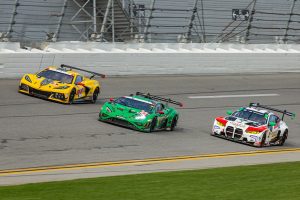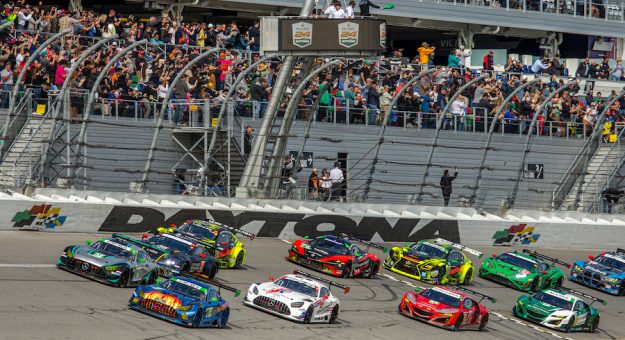Highlighted by a revamped GTP category comprised of all-new prototype sports cars, IMSA opened its season in late January with the 61st running of the Rolex 24 At Daytona at Daytona Int’l Speedway.
While the GTD (Grand Touring Daytona) and GTD Pro classes took a backseat to the new hybrid prototypes as far as attention, those two support divisions certainly did not lack for storylines.
But what exactly is the difference between GTD Pro and GTD?
From a technical standpoint, the cars are identical, running to global GT3 homologation rules based around balance of performance. The only difference between the cars in each class are the colors on the side mirrors, rear wing endplates and number plates. Those bodywork components are red for GTD Pro and green for GTD.

The classes also differ in that GTD Pro is designed for factory-backed teams running professional drivers while GTD is centered around customer teams and a Pro/Am driver lineup.
There are no driver rating restrictions for GTD Pro, but GTD allows one professionally rated driver (Platinum or Gold) per car to compete alongside a mandated amateur (Silver or Bronze) in a normal race lasting 2 hours and 40 minutes. Additional drivers are permitted for the endurance races with driver rating restrictions based on endurance race length.
While there are no earth-shattering changes for GTD Pro, there is a rather significant revision for the GTD class in qualifying. If a Bronze driver qualifies the car, that car may start the race on a new set of tires from its allocation. If a driver from another classification qualifies the car, that car must start on its qualifying tires.
Also, IMSA will recognize the top performing Bronze driver at each race with the Bob Akin Bronze Cup, named in honor of the late business executive, champion sports car racer and team owner. The best-performing Bronze driver over the season will earn the Bob Akin Bronze Cup Championship and receive an entry into the 24 Hours of Le Mans in 2024.
The GT classes have the largest manufacturer variety. Acura, Aston Martin, BMW, Corvette, Lamborghini, Lexus, McLaren, Mercedes and Porsche all have entries in the GT field with front-, mid- and rear-engined cars. This leads to a large battle over design philosophies and factory-backed drivers showing why their cars are superior.
However, not every manufacturer will have cars competing for the full season. Several competitors only contest the four endurance races, skipping the regular-length races and the 100-minute sprint race on the streets of Long Beach.
For example, perennial Ferrari competitor Risi Competizione, Porsche’s MDK Motorsports and Iron Lynx with its Lamborghinis are three such entrants, while Michelin Pilot Challenge regular Team TGM was only committed to racing the Rolex 24 with its Porsche.
Eight manufacturers contested the GTD Pro class among 10 cars. While Acura and McLaren were not represented, Aston Martin and Porsche each had two cars. The class win went to WeatherTech Racing’s No. 79 Mercedes AMG GT3 in Cooper MacNeil’s final IMSA start before retiring. The No. 3 Corvette C8.R finished second, just under four seconds behind, while the No. 14 Vasser Sullivan Racing Lexus RC F GT3 was third.
The No. 27 Heart of Racing Team Aston Martin Vantage GT3 backed up its 2022 GTD class championship win by topping the GTD category at the Rolex 24. The team also finished ahead of the GTD Pro-winning Mercedes.
However, the real story in GTD was the No. 57 Winward Racing Mercedes.
The team earned the GTD class pole in qualifying that took place a week before the race. During Thursday’s first practice session, Lucas Auer had a large accident when he hit the turn-two wall, sustaining injuries that prevented him from competing.
The team sent a small crew to their Texas shop to grab last year’s car, arriving at the track Friday morning. All hands were on deck as the team prepped the car for the race, finishing early Saturday morning.
On a late restart, Philip Ellis was trying to get back to the class-leading No. 27 Aston Martin. A daring lunge entering turn one got the car into second place in class, with only the No. 79 Mercedes and No. 3 Corvette GTD Pro entries between the GTD cars.
However, contact with the Corvette exiting turn one sent the Mercedes into the wall, damaging the left-rear suspension with just under 34 minutes to go. After leading 177 laps, the Mercedes limped back to the pit area.
